Australia is big. Like really big. And with an extremely low population density, Australia allows for some pretty amazing road trips. On this page I’ve summarized the most epic Australian road trip itinerary you can fit into three weeks.
There are countless road trip itineraries you can do in Australia. This one focuses on a route from Melbourne to Cairns that goes through South Australia, Northern Territory and across Queensland to the tropical north of the country. You will see the best that this mighty country has to offer on this epic Australian road trip. So let’s get going!
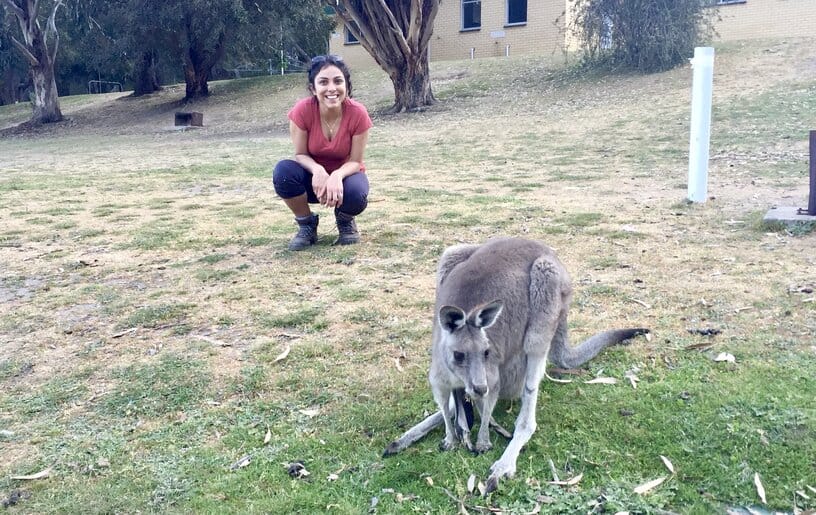
- The Epic Australian Road Trip Itinerary
- Day 1: Great Ocean Road
- Day 2: Grampians National Park
- Day 3: Pink Lake and Adelaide
- Day 4: South Australian Wine
- Day 5: Flinders Ranges National Park
- Day 6: Into the Outback
- Day 7: Lake Hart and Coober Pedy
- Day 8: Coober Pedy
- Day 9: On the Road to Uluru
- Day 10: Uluru-Kata Tjuta National Park
- Day 11: Uluru and Kata Tjuta
- Day 12: King’s Canyon National Park
- Day 13: West MacDonnell National Park
- Day 14: Alice Springs
- Day 15: An Endless Highway
- Day 16: Camooweal to Karumba
- Day 17: To the Tropical North
- Day 18: Palm Cove
- Day 19: Cairns
- Day 20: Great Barrier Reef
- Day 21: Cairns
Note: this article contains affiliate links, which means that should you purchase something or get a quote through them I may make a small commission at no additional cost to you. This helps keep the site running with up to date information. I do not represent World Nomads, Booking.com, GetYourGuide, or Rentalcars.com. This is information only and not a recommendation to buy the product mentioned in this article.
Australian Road Trip Itinerary – The Basics
Get there
This route will start in Melbourne. Melbourne is well connected to the rest of the world and you should be able to get there from any major city in the world with a one-stop flight.
Lay of the land
Australia is vast and open once you leave the big cities. Distances between stops might seem like a lot, but the miles go by fast. Most of the A87 in Northern Territory doesn’t even have a speed limit.
In much of the center of the country there are very few places to stop and put gas in the tank so make use of anywhere with a gas station (for snacks as well). Be prepared in advance by knowing where they are.
To campervan or car, that is the question
Before making this trip you’ll have to decide if you’re going to rent a car or a campervan (or RV). There are benefits of both. We chose the campervan method since there are many free places to park your vehicle overnight in Australia (see below). We also found it the cheaper option since accommodation in Australia can be expensive (especially in the middle of nowhere) and we are not huge fans of tent camping.
If you are in a campervan or RV you don’t really need to know exactly where you are going to stay every night, but in a car you will probably want a good idea before setting out.
If you go with the car rental option we recommend using Rentalcars.com. You can find a great deal on a rental car that will be your home for about three weeks as you make this epic drive.
If you do decide to do the road trip in a car, I’ve included some great options for accommodations on booking.com for each night along the journey.
Money
The currency in Australia is the Australian Dollar. You won’t need much cash, but it would be good to have some, especially if you’ll be camping as many campsites are cash only. Be warned that things in Australia are not cheap. It can come as a shock to first time visitors, but be prepared for price tags considerably more than you’re used to wherever you live.
However, the exchange rate will make things better for you, especially if you’re from the US. Tax is also included in the price (plus you don’t have to tip). It’s hard to put a price tag on the overall trip, but expect it to cost multiple thousands of dollars.
Freedom camping in Australia
One of the best parts about an Australian road trip is that freedom camping is allowed almost anywhere. See the section below on camping in Australia.
Kangaroos on the road
Kangaroos are everywhere in central Australia. Well, not everywhere, but you can’t drive across the Outback without seeing dead kangaroos on the side of the road. Kangaroos are most active at dawn and dusk. When driving at these hours you have to be extremely careful and always on the lookout for kangaroos.
You do NOT want to hit a kangaroo. That would mean an early end to your road trip and emergency help to tow away your damaged vehicle.
It is strongly recommended that on this road trip you don’t drive after dark, as it is much harder to avoid a kangaroo jumping in front of you if you can’t see them coming. Wallabies will also run out in front of your car here and there but they are much smaller and probably won’t damage your vehicle. That being said, please don’t kill any wallabies!

Snakes
There are venomous snakes all over Australia. Be careful in the Outback, especially after it rains. Rain brings the snakes out. If you get bit by a snake out in the middle of nowhere it can be life threatening at worst, and trip ending at best.
Flies
It cannot be understated how many flies there are in the Australian desert. I have seen nothing else like it in all my years of traveling the world (only comparison would be mosquitos in the Arctic in summer).
If your trip is in the warmer half of the year be prepared for flies all over you. They won’t ruin your trip and should not be a reason not to go, but they will be incredibly annoying and you will be cursing them. They are attracted to moisture – i.e. your face.
The only way to avoid them is to wait till the sun sets, as they stop swarming at night, or do the trip in winter.
Aborigines
The Outback has a high percentage of Aborigines, especially Alice Springs and Coober Pedy. The history of the British settlers and the Aborigines is not pretty. These days, with their way of life ruined, many of the indigenous population live off of government assistance and sadly many of them have fallen into alcoholism.
It’s not unusual to see dozens of Aborigines loitering around the cities in the Outback. Seeing children playing in garbage cans, their parents oblivious, was a very depressing experience. Try your best not to engage them if they seem drunk. If you want to help them out instead of giving them money directly, buy a painting by an Aboriginal artist from a shop in town.
Best time of year for an Australian road trip
The best time of year for this trip will be mid autumn. You don’t want to go in summer because it can be uncomfortably hot. Winter is the peak time for the Outback, but it’s a bit too cold for my liking and the days are shorter (see above about kangaroos on the road).
Also note that many popular hiking trails will be flat out closed in the summer. The Australian government mandates that trails be closed at 9 AM if the forecast that day is for temperatures over 36 Celsius (97 F). Even if the temperature never reaches the forecast. Trail will still be closed.
All major hikes in the Outback will have to be done at first light in the warmer months. Mid Autumn is probably the best time to go as the flies should not be as bad and the trails will be open.
Too much driving for you? Then you might be interested in a New Zealand road trip instead. Check out my two and three week New Zealand road trip itineraries for inspiration:
- The Ultimate 2 Week New Zealand Road Trip Itinerary
- The Perfect 3 Week New Zealand Road Trip Itinerary
Travel insurance
Before embarking on a journey like this, be sure to purchase travel insurance so that you’re protected for the unexpected. We use World Nomads when we travel. World Nomads provides coverage for travelers in over 100 countries. You can search for a coverage plan using the link below.
Further resources
For further information on the logistics of traveling across Australia, check out this Australian travel resources guide from the Australian Adventurer.
Camping and Campervan/RV Parking
If you are going to do this Australian road trip in a campervan, RV, or by spending some nights in a tent, you are going to want to download the WikiCamps Australia app. This app has compiled all the possible places to camp in the entire country and can be filtered by fee vs. free.
I used this app constantly on the road trip in order to figure out where we were going to stay the next night. It is not a free app, but for $8 it is worth it, especially if you plan on freedom camping.
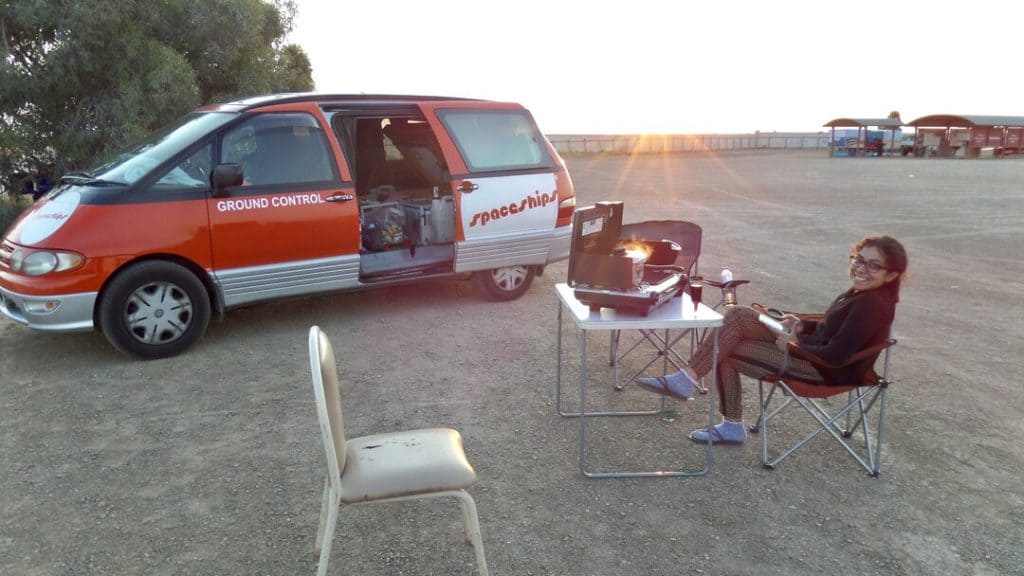
There may be a night or two when you simply cannot find a designated spot to camp at. Australia is a huge country with vast empty spaces so this can happen. While it is technically not legal to park just anywhere you want and camp, if you are in a van or RV you are pretty free to spend the night anywhere you wish when you are outside of a populated area.
Highway rest stops are popular places to spend the night. It’s totally fine to be unprepared for where you will spend the night if you’re in a van or RV. If you’re car camping though, I suggest having a plan to get a designated campsite before dark each day.
The Epic Australian Road Trip Itinerary
On paper this route covers about 3900 miles (6200 km), but that doesn’t account for any side trips off the main highways, which you will be doing quite regularly in the national parks. We recorded 8000 km total (which included backtracking 350 km one day after my wife forgot an expensive piece of jewelry in a gas station shower), so significantly more than the direct route.
This day by day Australian road trip itinerary will take you to many of the best spots in Australia and some of the most spectacular places in the entire world. It will last about three weeks if you follow it to the T. You’re going to love it!
Day 1: Great Ocean Road
Depart Melbourne in the morning and drive about 2-3 hours to one of the most iconic places in all of the state of Victoria, the 12 Apostles, which lie along Great Ocean Road, a lovely scenic drive in Port Campbell National Park.
Named after the 12 giant limestone rocks that once stuck up out of the ocean (4 have since eroded away), this is a very popular spot for day trips from Melbourne so you’ll have to fight your way through the hordes of other tourists for some good photos. But it will be worth it.

The stunning cliffs along the coast look like they belong somewhere on the west coast of Ireland and not southern Australia. Here you’ll mostly drive and stop at viewpoints. Some spots to be sure to hit are the Gibson Steps (where you can walk down to the beach below), the 12 Apostles Photo Area, Loch Ard Gorge, The Arch, and Bay of Islands, though there are many more.
When everyone else heads back to Melbourne you’ll head north about two hours toward Grampians National Park. Spend the night in the park or nearby in the small town of Halls Gap.
Where to stay in Halls Gap: Marwood Villas or Pinnacle Views
Day 2: Grampians National Park
Spend the day exploring Grampians National Park. A popular hike to do is the Wonderland Loop. There are many funky rock formations to climb all over. Be sure to stop at some of the popular points in the park on the side of the road too, such as MacKenzie Falls, Reed Lookout, and Boroka Lookout.
Stay again where you stayed the night before. Kangaroos come out to feed around dusk in the grassy areas of the town so if you want some photos with the ‘roos be back in town at sunset. Halls Gap Campground is a good place to see them.
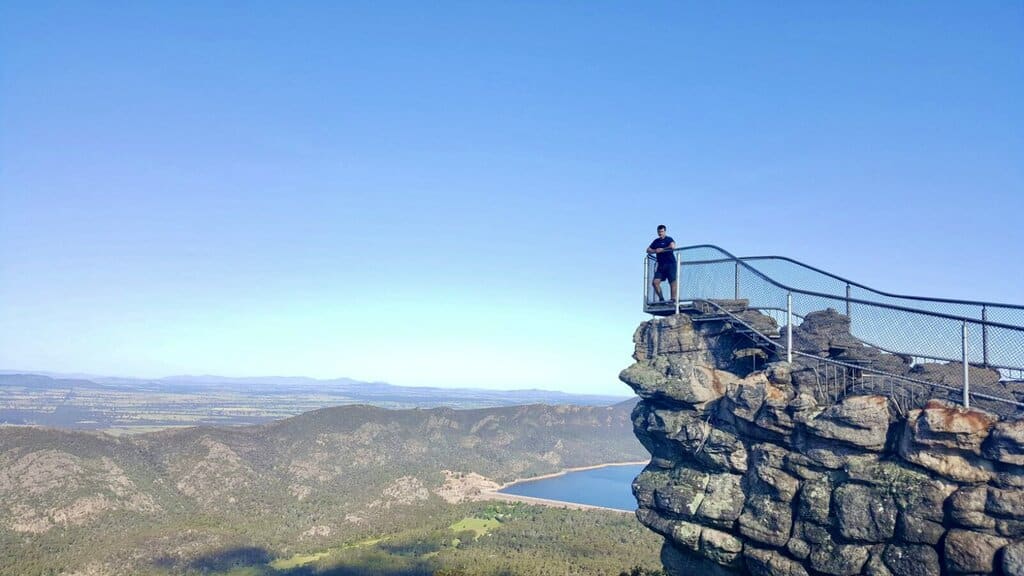
Day 3: Pink Lake and Adelaide
It’s about six hours to Adelaide from Grampians. Stop at Pink Lake along the way (right off the highway) and walk the salty lakebed to get some photos of the pink salt formations. FYI this is not the famous pink lake in Australia you’ve seen on Instagram (that is on a small island in West Australia, nowhere near here) but it’s pretty cool nonetheless.
Get to Adelaide by late afternoon. We chose to skip the city and stay in the lovely beachside suburb of Grange. Bonus: if you have extra time add a few days to go to Kangaroo Island just south of Adelaide. I still regret not going there.
Where to stay in Adelaide: Majestic M Suites or TRYP by Wyndham
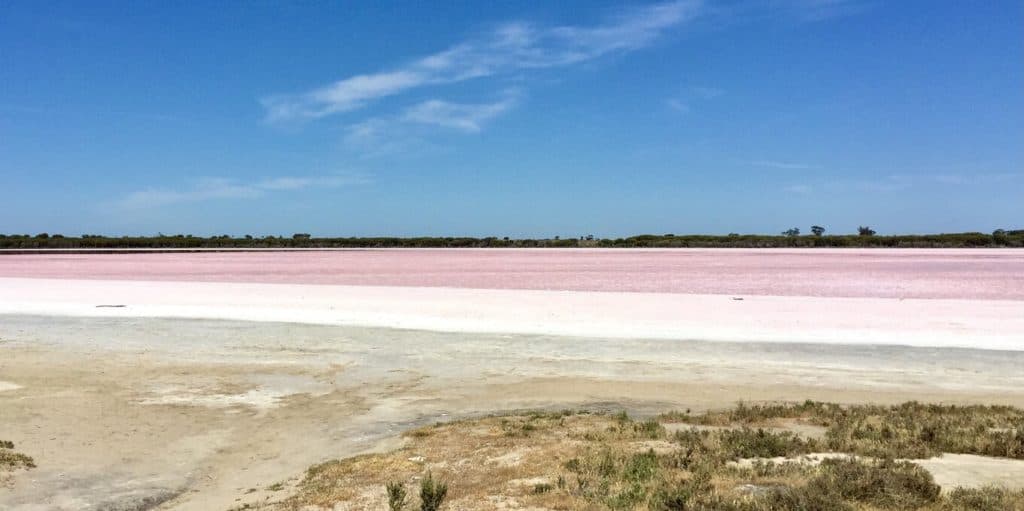
Day 4: South Australian Wine
South Australia is known for its red wine, but there is one region that is known more for Riesling. Head to the little town of Clare for some wine tasting in a beautiful vineyard-clad valley. But you can still try some famous South Australian Shiraz as well as many local Rieslings.
The most well known winery in town is Sevenhill Cellars, so hop on over for some pretty heavy – like 15% heavy – wines. Spend the night in Clare or continue north and freedom camp somewhere along highway B80.
Where to stay in Clare: Neagles Retreat Villas or Clare Country Club
Day 5: Flinders Ranges National Park
Drive north (about 4 hours is leaving from Clare) to Ikara-Flinders Ranges National Park. The mountain range is not large or tall, with its peak only about 1170m (3840 ft), but the park features a vast arid desert landscape with red rocks and unusual creatures.
Spend the afternoon exploring the park and spend the night in the park. If you’re in a car, the nearest town is Hawker, though there is a resort in the park if you’re willing to pay for it.
Where to stay around Flinders Ranges: Wilpena Pound Resort or Skytrek Willow Springs Station
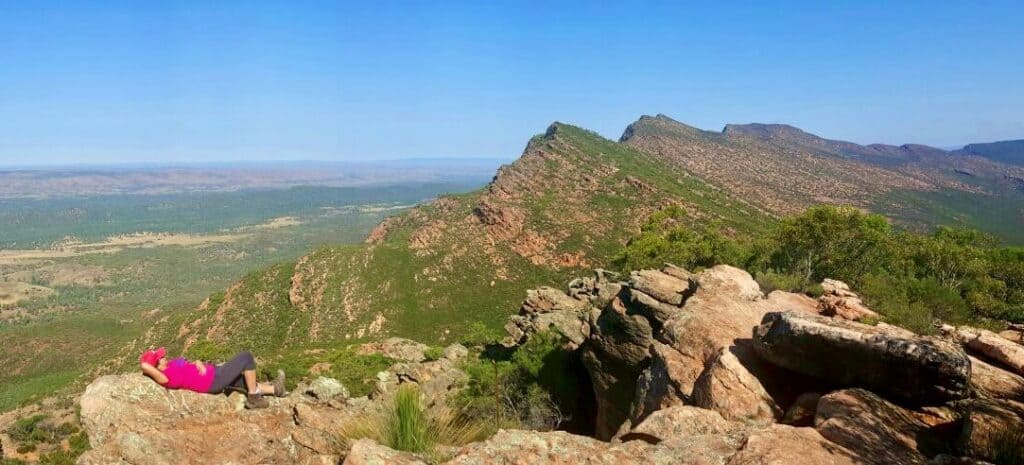
Day 6: Into the Outback
Start out your day with the Mount Ohlssen Bagge hike in Flinders Ranges National Park. After you’re satisfied with the park, head to Port Augusta for a decent meal.
Wave goodbye to the ocean here because it’s the last time you’ll see it for a while. You will now enter the arid and inhospitable landscape of South Australia. The roads here are lonely, flat and straight. Miles and miles will pass without a change of scenery out your window.
But don’t despair, this part of the country is full of some pretty cool dry lake beds and endless salt flats. There are some amazing national parks here, but for this trip I’m assuming you don’t have a 4WD vehicle. That’s ok because tomorrow you’ll get to see an awesome salt flat.
For today though, make your way to Woomera and learn a little about nuclear bomb testing. The town itself is mostly abandoned these days, but there are a few places to camp or stay. Or if you’re in a campervan, head back to Pimba on the highway and park for the night at Spud’s Roadhouse, which is nothing more than a gas station with a free overnight parking lot.
Where to stay in Woomera: really just the Woomera Traveler’s Village
Day 7: Lake Hart and Coober Pedy
From Woomera, it’s only about a four hour drive to Coober Pedy. But first you will stop at Lake Hart. Luckily you don’t have to go off road at all to see the vast salt flats here, as the lake is just off the side of the highway.
Don’t forget your sunglasses. When the sun reflects off the white surface of the earth it can burn your eyes. After some nice photos at Lake Hart hit the highway again and head to Coober Pedy. If you need gas, stop in Glendambo, because for about the next 3000 km you are going to be in the middle of nowhere.

There are parts of the US, like northern Nevada, that are isolated, but nothing compares to central Australia. I love it. In Coober Pedy you don’t want to camp because here you will get to experience underground living.
Book an underground hotel or hostel. It won’t be hard since nearly everywhere to stay is underground. Temperatures are pretty extreme in this town but underground it stays a comfortable 24 degrees (74 F) year round. There are shops and restaurants underground too. It’s a neat thing to experience.
Where to stay in Coober Pedy: Ali’s Underground Home or The Underground Motel
Day 8: Coober Pedy
I recommend spending a rest day in Coober Pedy. If you don’t want to do that you can head on to Day 9, but if you want to sleep in for a change, spend the day in Coober Pedy and the surrounding area. There isn’t a ton to do here but it’s easy to fill a day.
Coober Pedy is the opal mining capital of the world, so you can head to the Umoona Opal Mine & Museum if you want to learn more (I didn’t want to pay for it).
If you want to feed a kangaroo head over to Josephine’s Gallery and Kangaroo Orphanage. Get there by noon for the feeding.
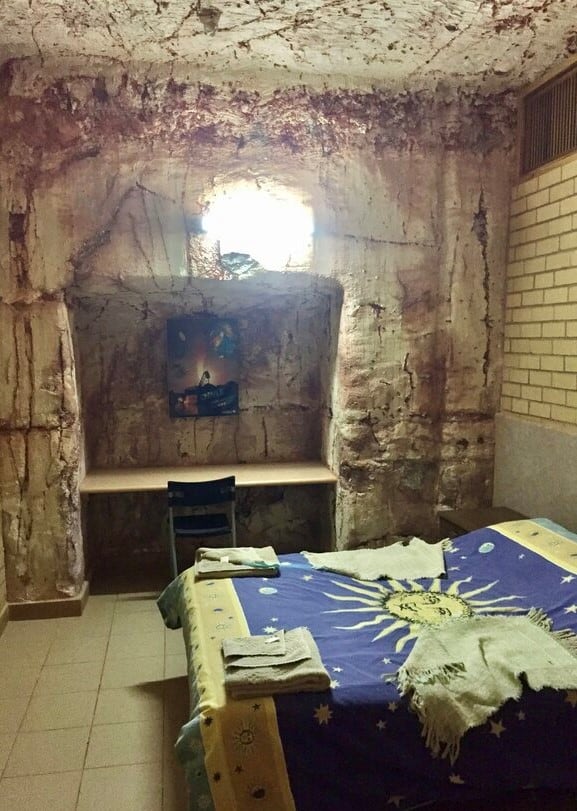

After lunch get out of town for a bit and do the scenic drive through the Breakaways, a region of colorful badlands with some funky earth formations (you’ll need to buy a $10 pass first from the visitor center in town).
Out here you can also see the longest manmade structure in the world, the Dingo Fence. The fence keeps dingoes out of the fertile regions of the southern part of the country so they don’t destroy crops. Back in town, make sure to try some emu before leaving Coober Pedy.
Day 9: On the Road to Uluru
Head north along the Stuart Highway – the only north-south running highway in central Australia – towards Northern Territory, a giant state of endless desert. There is no way to sugarcoat it, this drive will be boring. For hours upon hours there will be nothing on the side of the road except endless red sand and desert brush, maybe a wild camel here and there.
It’s at least seven hours to Uluru-Kata Tjuta National Park, the crown jewel of the Australian Outback. There is a small tourist town called Yulara that you can stay at just outside the park boundary.
There are many lodging opportunities here from camping to luxury rentals at the Ayers Rock Resort. We chose to stay outside the park in a freedom camping spot called the Curtin Springs Cattle Station.
Note that if you are doing the campervan option, it can be very hot in your van in this part of the country. There are dingoes in this region so don’t be tempted to leave the van doors open. You’re on the dingo side of the dingo fence after all.
Where to stay around Uluru: pretty much everything is part of Ayers Rock Resort. They have a monopoly over the region. From camping to luxury stays, they have it all.
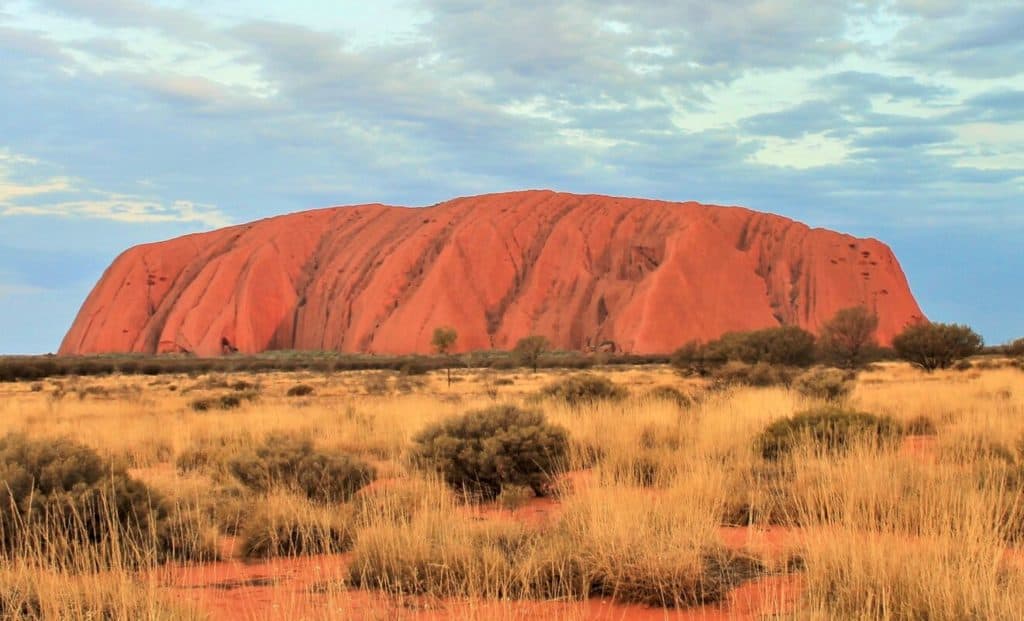
Day 10: Uluru-Kata Tjuta National Park
Today you will see one of the most iconic sites on the planet: Uluru, aka Ayers Rock. Depending on where you stayed the night before you might have had a distant glimpse of it from the road. But as you drive towards the rock you will get many amazing views of it.
I won’t go into detail about this incredible national park here, but check out my other post about Uluru for more detailed information. The park will cost you $38 AUD (when I visited it was only $25) per person for a three day pass. You can buy it ahead of time online or pay when you arrive at the entrance station.
Spend the day exploring the area around this one-of-a-kind rock, the largest monolith on the planet, and if you’re up for it, do the hike around it. Catch the sunset at Uluru Sunset Viewing Area and enjoy the lack of flies as the skies darken. For spending the night, again there are many options in the park but if you want to freedom camp you’ll have to leave the park boundary. That’s OK because your pass is good for three days.
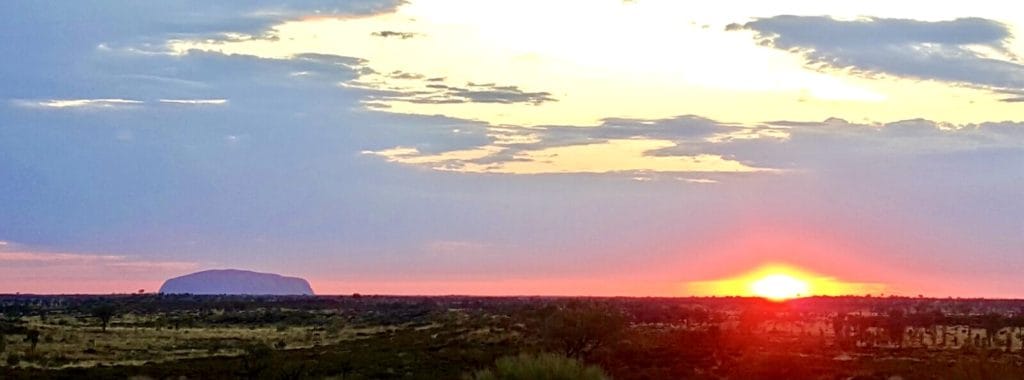
Day 11: Uluru and Kata Tjuta
If you’re up for rising super early, head to the Uluru Sunrise Viewing Point for the best views of the sunrise over the rock. Being up early also allows you to get some hikes in before the trails close (see previous discussion on trails closing due to heat).
You can no longer climb Uluru itself but there is a great hike on the other side of the park in Kata Tjuta that you’ll need to start before 9 AM if you’re there in the warmer half of the year. So get in your vehicle and head west about 30 minutes to much forgotten but equally as beautiful Kata Tjuta, aka the Olgas.

The Valley of the Winds hike will take you up and around these funky sandstone formations of red rock. If you start early enough you’ll be able to avoid the crowds.
After Kata Tjuta, head back to Uluru and check out the cultural center and bask in the beauty of the rock a bit more before heading on. While this place is simply stunning, there actually isn’t that much to do here once you’ve done the two walks I’ve recommended.
If you’re up for a camel ride, stop by Chris Hill’s Uluru Camel Tours before leaving the area. It’s about 3 hours to Watarrka National Park, where you’ll spend the night outside the park.
Where to stay around Watarrka National Park: Discovery Kings Canyon or Kings Creek Station
Day 12: King’s Canyon National Park
Get up early again so you can start the King’s Canyon Rim hike in Watarrka National Park. I wasn’t able to do this hike as I arrived in the park after 9 AM, so don’t make the same mistake I made and get in early.
This park is not nearly as visited as Uluru-Kata Tjuta, so it will feel more quiet and relaxed. It’s a small park though and there really isn’t much else to do once you do the rim walk.
From here it’s about 2-3 hours to the western end of Tjoritja / West MacDonnell National Park, the final national park on your tour through the Outback in Northern Territory. Spend the night in one of the small campsites outside the park.
If you’re in a car and only doing hotels, you’ll have to stay another night by Watarrka because there are no hotels or hostels near Tjoritja / West MacDonnell.
Day 13: West MacDonnell National Park
Tjoritja / West MacDonnell National Park is full of stunning gorges and red rock formations, but it’s probably more known for the fact that it actually has some water, a rare sight in the Outback. Not really lakes, but small watering holes next to towering sandstone cliffs.
Take a break from long hikes and bring your bathing suit. Some places to check out are Ormiston Gorge, Ellery Creek Big Hole, and Stanley Chasm.

When you’re satisfied you’ve seen enough of the beautiful landscapes of the Australian Outback, head east towards Alice Springs, the only real city in central Australia. Once you leave Alice Springs you won’t see mountains again until you hit the east coast, so don’t leave the park too soon.
If you’ve been camping while in the Outback take this opportunity to stay somewhere in Alice Springs with air conditioning. It’s going to feel amazing after four nights camping or campervanning in the desert. Get yourself a nice dinner in Alice Springs because you’ve earned it.
Where to stay in Alice Springs: Alice’s Secret Travellers Inn or Desert Palms Alice Springs
Day 14: Alice Springs
At this stage in the road trip I recommend taking another rest day. There isn’t too much to do in Alice Springs, but you’re about to drive 2200 km across the desert to get to the tropical north of the country and you will want to be well rested.
If you want to see desert wildlife up close in a controlled environment and learn a little more about the desert, check out the Alice Springs Desert Park. For a nice view of the city and the red mountains that surround it, drive up to ANZAC Hill.
If you’re up for trying some game meat, head over to the Red Ochre Grill for some camel. Australia is actually the only county in the world with wild camels. But they also farm them for meat. Tastes sort of like bison. Enjoy the air conditioning once more and get ready for some long days of driving ahead.
Day 15: An Endless Highway
Time to make some ground. You’ve seen the highlights of the Australian Outback already. There are, of course, many more amazing places in the desert, especially in Western Australia. But the desert in Australia is massive, nearly the entire country, and these places are not close.
There is not much on the highway as you head north from Alice Springs. Not too far outside of the town the speed limit disappears. It’s an open speed area, like a German highway. If you’re in a campervan or an RV you won’t want to move much faster than 130 kmh (80 mph) though.
The road is in good condition, just watch out for the road trains – tractor trailers that are tied together to basically make a train. The dead kangaroos you see were most likely hit by a road train. The highway is flat and endless and it can be easy to fall asleep, so stay alert.
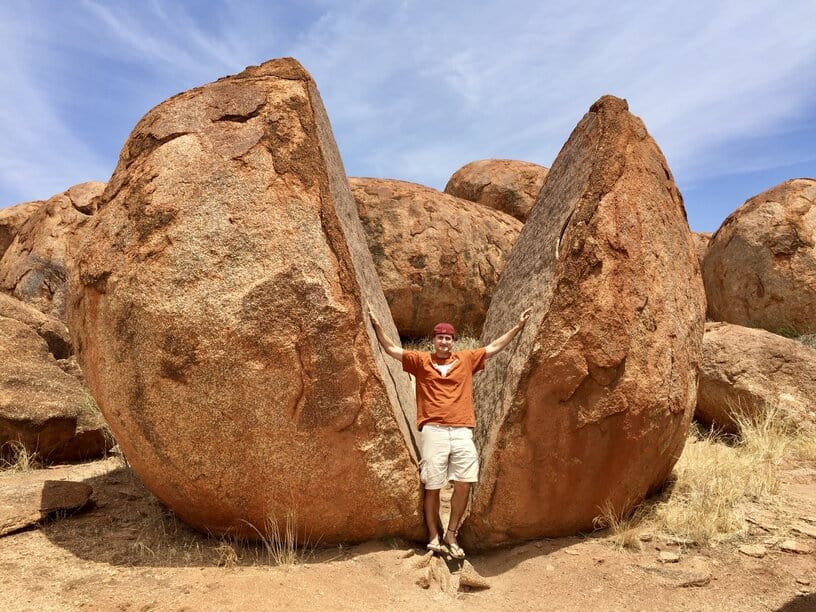
Four hours north of Alice Springs you can stop at the Devil’s Marbles, an area of surprisingly spherical boulders just on the side of the highway. From there, keep north till you get to Tennant Creek then head east on highway 66 towards Queensland.
One important thing to note is that you are not supposed to bring produce into Queensland, so if you have any fruits or vegetables eat them before entering Queensland. Arrive late into Camooweal and spend the night in the tiny little town. If you’re not camping there’s really only one option for lodging, the Camooweal Post office Hotel.
Day 16: Camooweal to Karumba
Another long day on the road. There are a few different ways to get to Cairns from Camooweal so the choice is yours. We took the northern route to get a little change of scenery after nearly two weeks in the desert. It is still pretty arid on the drive, but the redness of the desert eventually fades out.
Head east on the A2 through Mount Isa to Cloncurry, then take highway 83 north and watch the vegetation change as you drive. If you want to see the northern coast of Australia you can head to the little beach town of Karumba. We ended up staying here because the town at the intersection of the A1 highway – Normantown, was really run down.
It’s about 45 minutes out of the way but worth it to have a beer on the coast and watch the sunset. There are also a ton of wallabies in the area so you will surely see hundreds of these furry mini-kangaroos. Just don’t go in the water unless you want to be dinner for a hungry crocodile!
Where to stay in Karumba: Karumba Point Sunset Caravan Park
Day 17: To the Tropical North
The last day of driving. It’s about 8 hours across the northeast peninsula of Australia to Cairns, on the country’s tropical northeast coast. Try not to kill any wallabies on the drive.
As you get closer to Cairns you will notice a striking change in the landscape. All of a sudden green fields start appearing, fertile farms growing sugarcane and watermelon. Trees appear again. Mountains covered in lush vegetation appear on the horizon. It’s hard to believe that yesterday morning you were in the middle of the desert.
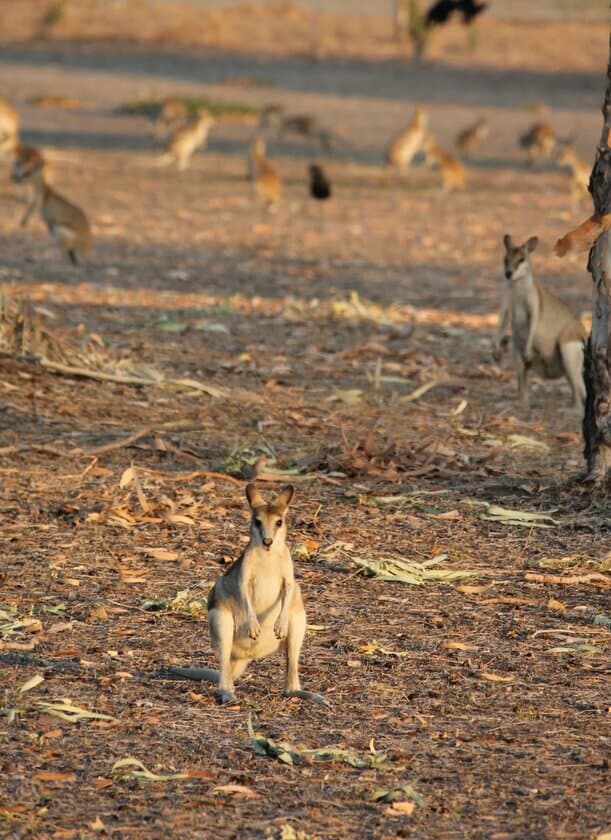

This part of the country has a tropical climate. It’s the same latitude of places like Fiji and Bora Bora, though often forgotten in the conversation with those tropical paradises. To reward yourself from all the driving you’ve done you will spend the remaining days of the trip in the Cairns region enjoying beautiful beaches and the world famous Great Barrier Reef.
We chose to spend our first few nights in the northern beach town of Palm Cove. A lovely little posh suburb of Cairns, it was the perfect place to relax after 8000 km on the road.
Where to stay in Palm Cove: Paradise on the Beach Resort or Sanctuary Palm Cove
Day 18: Palm Cove
Take a day to just relax at the beach. Whether you’re at Palm Cove or another one of the beach towns (be warned there is no actual beach in Cairns city so you have to go north of the city to find the beaches), you can enjoy a calm day at the beach surrounded by lush palm trees and green mountains.
If you’re there in the summer you’ll have to swim in designated areas that are netted off to prevent box jellyfish from biting you. These are incredibly poisonous and are found in this region. They only appear in the summer months though.
Under no circumstance should you attempt to go in the water outside of the nets during jellyfish season.

Day 19: Cairns
Cairns is not far from Palm Cove, only 20-30 minutes. But take your time and stop at Skyrail Rainforest Cableway, which will take you up into the dense Australian rainforest. You can also learn all about this fascinating ecosystem. Remember just a few days ago when you were deep in the heart of the desert?
Heading into the city, return your rental car or van, as it’s super easy to walk everywhere in Cairns (though I suggest dropping your bags off at your accommodation first). Cairns is a thriving city of about 150,000 people (including metro area) so you can find any sort of accommodation you want. Stay downtown if you can so you can walk everywhere.
Where to stay in Cairns: Shangri La The Marina or Crystalbrook Riley
Day 20: Great Barrier Reef
Today is for the Great Barrier Reef, one of the seven wonders of the natural world. Be sure to book your tour ahead of time and don’t depend on booking something when you get there. The only way to see the reef – other than renting a boat or taking your own boat – is to take a reef tour.
You can book one of the many Great Barrier Reef tours available on GetYourGuide here.
The reef is huge and there are many locations you can start a tour from, but Cairns is the most popular as it’s the main population center along the reef. The tour will cost you about $200 AUD each, but it’s well worth it. You’ll get to snorkel or dive over an amazing underwater universe.

Nothing can describe how beautiful the reef is, even if it is rapidly dying. If you’re snorkeling just be sure to use plenty of sunscreen. I’ve never had a burn as bad as I had after four hours snorkeling in the Great Barrier Reef.
Day 21: Cairns
Your last day in Australia. Spend the day exploring the city. Walk along the Cairns Esplanade, take a dip in the lagoon, and check out one of the many outdoor bars along the coast.
It’s humid as hell in Cairns so you might feel like you need to take multiple showers. Brush it off and have a beer on the water instead. Head over to Ochre Restaurant for some epic Australian fare. Though be warned, it appears that crocodile is no longer offered at restaurants in Cairns. If you haven’t tried a kangaroo steak yet, this is your last change. Kangaroo is by far my favorite red meat.
It’s your last night in the country so go all out. What a journey it has been!
The End of this Epic Australian Road Trip Itinerary
All good things must come to an end. Your epic Australian road trip adventure is over. Fly out of Cairns and bid farewell to this biodiverse country. You’ll be back. I’m sure of it.


1 comment
[…] a Road Trip in Australia? The coastal highway between Brisbane and Cairns is one of the more popular road trips in […]